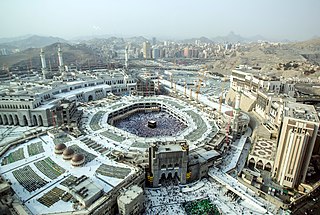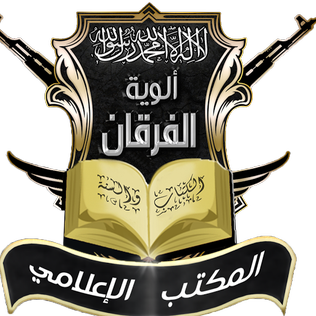
Glasgow Central Mosque is located on the south bank of the River Clyde in the Gorbals district of central Glasgow. The website "Muslims in Britain" classifies the Glasgow Central Mosque as Deobandi.

Islam in Scotland includes all aspects of the Islamic faith in Scotland. The first Muslim known to have been in Scotland was a medical student who studied at the University of Edinburgh from 1858 to 1859. The production of goods and Glasgow's busy port meant that many lascars were employed there. Most Muslims in Scotland are members of families that immigrated in the later decades of the 20th century. At the 2011 census, Muslims comprised 1.4 per cent of Scotland's population (76,737). In the 2022 census, this grew to 2.2% of the population (119,872).
The Islamic Education Society is an Islamic organization in Bahrain that follows and promotes the conservative Salafist ideology. It participates in politics through its political wing, Asalah.

The True Furqan is a book written in Arabic that tries to imitate the Qur'an while incorporating elements of traditional Christian teaching.

Haqā'iq al-Furqān is a 4 volume exegesis of the Quran compiled from the discourses and sermons of Hakeem Noor-ud-Din, the first Caliph of the Ahmadiyya Muslim Community. The work is in Urdu.

Masjid al-Haram, also known as the Sacred Mosque or the Great Mosque of Mecca, is considered to be the most significant mosque in Islam. It encloses the vicinity of the Kaaba in Mecca, in the Mecca Province of Saudi Arabia. It is among the pilgrimage sites associated with the Hajj, which every Muslim must perform at least once in their lives if able. It is also the main site for the performance of ʿUmrah, the lesser pilgrimage that can be undertaken any time of the year. The rites of both pilgrimages include circumambulating the Kaaba within the mosque. The Great Mosque includes other important significant sites, such as the Black Stone, the Zamzam Well, Maqam Ibrahim, and the hills of Safa and Marwa.

Taha Sobhi Falaha, better known by his nom de guerreAbu Muhammad al-Adnani al-Shami, was a Syrian militant leader who was the official spokesperson and a senior leader of the Islamic State. He was described as the chief of its external operations. He was the second most senior leader of the Islamic State after its leader Abu Bakr al-Baghdadi. Media reports in August 2016 suggested he was in charge of a special unit, known as the Emni, that was established by IS in 2014 with the double objective of internal policing and executing operations outside IS territory.

Alwiya al-Furqan is an independent Islamist rebel group involved in the Syrian Civil War. It claimed to be the largest Islamist rebel faction that operated in the eastern Quneitra Governorate and Damascus. The group also held ties to Jordan which allowed fighters from the group to cross into the country to receive medical aid.

Abū Ḥātim al-Muẓaffar al-Isfazārī was an Islamic mathematician, astronomer and engineer from Khurasan. According to the historian and geographer Ibn al-Athir and the polymath Qutb al-Din al-Shirazi, he worked in the Seljuq observatory of Isfahan. The Persian writer Nezami Aruzi met him in Balkh in in 1112 or 1113.

Abd al-Rahman Mustafa al-Qaduli, better known as Abu Ali al-Anbari, was the governor for territories held by the Islamic State of Iraq and the Levant (ISIL) in Syria. Considered the ISIL second-in-command, he was viewed as a potential successor of ISIL leader Abu Bakr al-Baghdadi.

The Islamic State (IS) had its core in Iraq and Syria from 2013 to 2017 and 2019 respectively, where the proto-state controlled significant swathes of urban, rural, and desert territory, mainly in the Mesopotamian region. Today the group controls scattered pockets of land in the area, as well as territory or insurgent cells in other areas, notably Afghanistan, West Africa, the Sahara, Somalia, Mozambique, and the Democratic Republic of the Congo. As of 2023, large swathes of Mali have fallen under IS control.

The 2015 Sana'a mosque bombings were four suicide attacks targeting two mosques on 20 March 2015 in Sana'a, Yemen.

Ansar Al-Furqan is a Sunni Baloch militant organization active in Sistan and Baluchestan insurgency and a designated terrorist organization by Iran. The group was established in December 2013 by a merger of Harakat al-Ansar and Hizbul-Furqan.
Shia Muslims have been persecuted by the Islamic State (IS), an Islamic extremist group, since 2014. Persecutions have taken place in Iraq, Syria, and other parts of the world.

The Aqsa Mosque is the largest and oldest mosque of Qadian, India. It is situated inside the compound of the ancestrial house of Mirza Ghulam Ahmad, close to the White Minaret, and located in the Ahmadiyya Mohallah of Qadian.
Kampung Padang Balang or Padang Balang is the oldest surviving traditional village in Kuala Lumpur, Malaysia. It is circumferenced by Gombak Road, Jalan Kampung Bandar Dalam, Duta–Ulu Klang Expressway (DUKE), Kuala Lumpur Middle Ring Road 2 and Gombak River.
On 24 September 2015, a double suicide bombing was carried out by Islamic State at a mosque in Sana'a, Yemen, killing at least 25 people.













